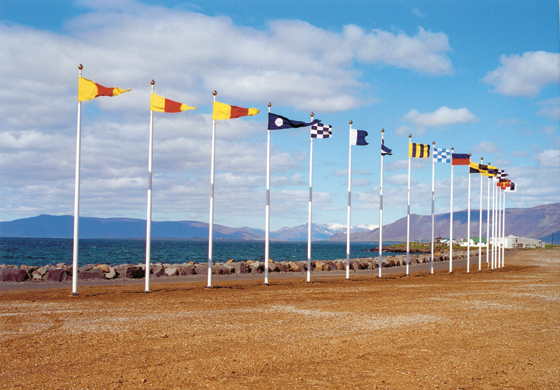Coastline 2000, Reykjavik, Iceland
artdesigncafé - art | 10 December 2010
This article was previously published in Sculpture, 20(7), page 81 in 2001.
-

Anna Eyjolfsdottir. Signaling Coastline (2000). Flag poles, ships‘ signal flags; 600 x 3600 x 120 cm. Installed at Reykjavik Harbour as part of outdoor exhibition: Coastline 2000, Reykjavík, Iceland. Photo: Helgi Hjaltalín Eyjólfsson. The 17 ship-signaling flags spell out “Coastline” in Icelandic to ships that approach the land.
Coastline 2000, Reykjavik, Iceland
“One day I hope the exhibition will go out to sea,” says Reykjavik Sculptors’ Association President Anna Eyjolfsdottir about Coastline 2000. “We have to get more exposure— many people think we only have fish here in Iceland.” Organized by the Sculpture Association, this outdoor exhibition is the third of the Invasion series, after Coastline ’98 and Firma ’99 in nearby locations, and the three shows celebrate the 90-member association’s 25th anniversary.
Located just north of the city’s downtown harbor along a 2,000-meter-long coastal stretch, the site for Coastline 2000 parallels an adjacent road with dramatic views of Mountain Esja across the water in the distance. Sculptures are placed between the water and road and can be experienced by boat, car, bicycle, on foot, or from the window of a passing plane. Exhibited during the long, light-saturated summer days, Coastline 2000 featured 15 sculptures by artists from Iceland, Norway, and Poland.
The exhibition’s objective was to present site-specific works related to the sea, land, and road; shipping; the view of the mountain and its symbolism; the weather as a reference point; and spiritual and historical aspects.
As expected within the context of Icelandic traditions, the content and forms of the sea and shipping emerged in the works to varying degrees. Rosa Gisladottir’s cement Fossilised Future (2000) consists of monumental, stylized impressions of sea life in concrete, playing on their associations as humbling timeless symbols. Gisladottir raises questions about the sea’s future health and what the next 1,000 years will bring.
Using the form of a ship’s steering wheel, Bubbi (otherwise known as Gudbjorn Gunnarsson), presented 360 degrees (2000), which acts as a mechanism framing visual space. Made of Plexiglas, steel, sea water, and antifreeze, the three-meter-high sculpture plays off the sea, land, and horizon line. Nearby, Nidur (2000) by Haraldur Jonsson consisted of a sound sculpture activated by a large industrial pipe positioned above sea level, directing the sounds ashore, a device that refers to the often questionable interventions of mankind and industry.
Dealing more with physical distances and vantage points, Agnieszka Wotodszko from Poland displayed a sculptural piece with sound, drawing on interviews with people from the town of Akranes, which can be seen across the harbor. The artist asked residents about how they view “big city” Reykjavik and its connection to Akranes, with the selections displaying big city/small town rivalries, perspectives, and information gaps. The work illustrates the human impact of physical distances and geography. Similarly, Anna Eyjolfsdottir’s Signaling Coastline (2000) makes land- and sea-based distinctions with 17 ship-signaling flags spelling out Coastline in Icelandic.
Other works addressing land associations include I Have a Dream (2000) by Laila Kongevold from Norway. Distributed on both sides of the road and consisting of various-sized aluminum cutouts of sheep taken from a religious image, the piece literally refers to the dangers of sheep being struck by autos in the Icelandic countryside. More symbolically, Dream also represents the dangers of life in a religious context, with the title’s reference to Martin Luther King, Jr.
Also referring to death on the road, Inga Jonsdottir’s Memento Mori (2000) offers imagery of x-rays relating to human road accident victims in Iceland, while the form refers to the steer at the back of a boat. At 180 centimeters tall, the piece acts as an abstract road sign for passing car traffic.
Meanwhile, Gudjon Ketilsson’s Sunday (2000) uses imagery from “Sunday mornings”— chair, pressed shirt, and shoes— and refers to the artist’s childhood memories of “one’s mind being elsewhere.” Gretar Reynisson’s Length of time (2000) runs along the rock-built sea wall and along the exhibition path. With 59 plastic sign plates distributed every 34 meters, the piece “measures” 2,000 years— expressed in meters, referring to the Christian millennium, the physical space of the site, and the artist-measured symbolic distance, as well as the Icelandic burial crosses that use these plastic signs.
Are there challenges in being a sculptor in Iceland? Anna Eyjolfsdottir mentions concern about equal art opportunities between the sexes, but foremost is isolation. To address this, Icelandic artists study at European and North American art schools and bring back knowledge of other approaches. Despite its relatively small population of less than 300,000, the country may have the world’s highest percentage of artists in its population— and good ones to boot.
For Anna Eyjolfsdottir, “Iceland’s isolation makes things difficult. For example, we’ve never taken an exhibition to New York— not yet. That’s the idea behind taking the sculpture to another country. Maybe we will go abroad with some pieces. To take a boat to… another place.” Eyjolfsdottir hopes that another exhibition— a fourth— will result in taking sculpture on the high seas, on a North Atlantic voyage to, yes, another coastline.